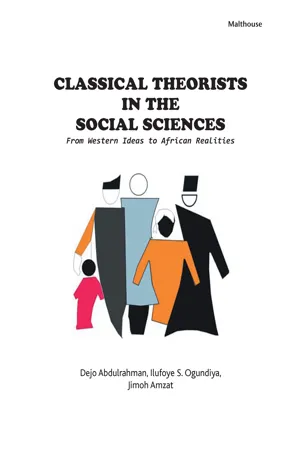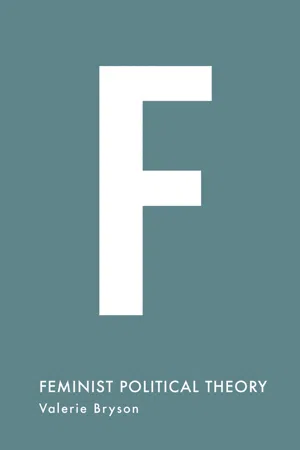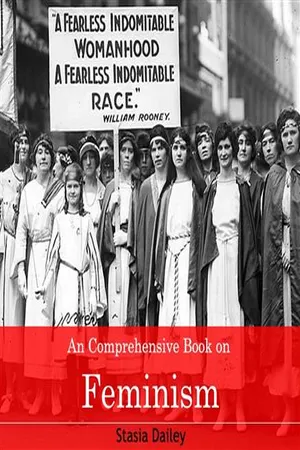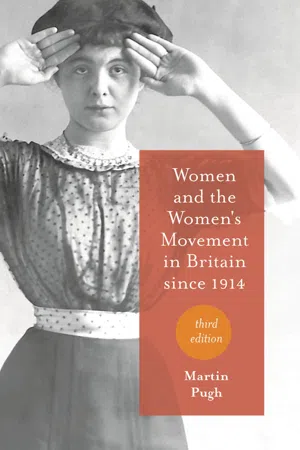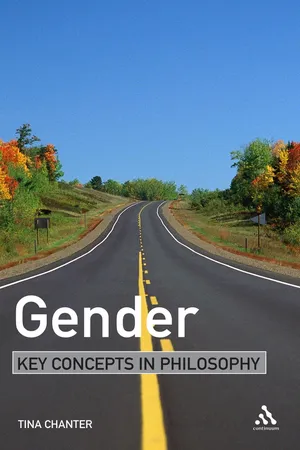History
Feminism in Britain
Feminism in Britain has a rich history dating back to the late 19th century, with key milestones including the suffragette movement and the emergence of second-wave feminism in the 1960s and 1970s. British feminism has been instrumental in advocating for women's rights, challenging gender norms, and addressing issues such as reproductive rights, domestic violence, and workplace equality.
Written by Perlego with AI-assistance
Related key terms
1 of 5
6 Key excerpts on "Feminism in Britain"
- eBook - PDF
Classical Theorists in the Social Scienc
From Western Ideas to African Realities
- Dejo Abdulrahman(Author)
- 2023(Publication Date)
- Malthouse Press(Publisher)
Therefore, feminism could be regarded as the struggle to end sexism, sexist exploitation, and oppression (Hook, 1984). It does not privileged women over men, but seek the engagements of social movements for defining, establishing, and achieving equal opportunities for women and men in politics, economic, cultural, personal, human and social rights (Fine & John, 1994). In view of these aspirations, varying definitions of feminism have emerged. For instance, Smith (1979) defines feminism as “… the political theory and practice to free all women: women of colour, working – class women, poor women, physically challenged women, lesbians, old women, as well as white economically Classical Theorists in the Social Sciences: From Western Ideas to African Realities 380 privileged heterosexual women…” Furthermore, Brannigan (2003, p.179) opines the original meaning and impetus of feminism is “… the long-standing history of control and dominance by men throughout the world, men who have not viewed women as their equals.” Rich (1976) also claims that feminism implies women’s ability to renounce their obedience to the fathers; recognize the fact that the world the fathers’ have described is not the whole world; and recognize fully the inadequacy and the distortion of male-created ideologies so that they can proceed to think and act out of that recognition. Therefore, feminism could be sum-up as a reaction to injustice against women and girls by men and the society to which they belong. Who is a Feminist Thinker? Feminists are individuals who advocate and support the rights and equality of women in all spheres of life. They seek to establish equal opportunities for women in politics, governance, health, economics, education and employment; and to challenge all forms of unfair and unequal distribution of power and wealth in patriarchal society. They argue that women should share equally in society’s opportunities and scarce resources. - eBook - ePub
- Valerie Bryson(Author)
- 2016(Publication Date)
- Bloomsbury Academic(Publisher)
5 LEFT-WING Feminism in Britain AND THE UNITED STATES FROM THE LATE NINETEENTH CENTURY TO THE SECOND WORLD WARAs we shall see in Chapter6 , by the late nineteenth century some European countries saw a sharp split between ‘mainstream feminists’ with their demands for equal political and legal rights, and Marxist socialists with their talk of class war and revolution. In both Britain and the United States, however, there was much more of a continuum, as the social concerns that had long characterised sections of the women’s movement merged with a more radical critique of existing society which led some to socialism as well as feminism. For most, this socialism was based on humanitarian ideals or a pragmatic response to poverty and the conditions of working-class life. Such socialism owed little to Marxist ideology, it favoured gradual and piecemeal reform rather than revolution, and it could seem readily compatible with a feminism based on ideas of social justice rather than on an analysis of patriarchy. In this context, socialism and feminism could be seen as complementary, promising equality and an end to exploitation for all. At the same time, other women activists developed their feminism in the context of anarchist or communist politics, insisting both that society must be radically transformed and that women must play a key role in this transformation, while some black women communists developed analyses of the intersections of race, class and gender that anticipate later thinking.BritainAlthough many male socialists supported feminist goals, in practice socialist organisations in both countries tended to combine formal commitment to a degree of sex equality with a marginalisation of ‘women’s issues’, discriminatory practice and a frequently unthinking sexism that permeated all levels of political and personal life. Thus Hannah Mitchell, a working-class socialist and suffrage campaigner from the north of England complained: - No longer available |Learn more
- (Author)
- 2014(Publication Date)
- Library Press(Publisher)
________________________ WORLD TECHNOLOGIES ________________________ Chapter- 1 History of Feminism Louise Weiss along with other Parisian suffragettes in 1935. The newspaper headline reads, in translation, THE FRENCHWOMAN MUST VOTE. The history of feminism involves the story of feminist movements. Most feminist historians assert that all movements that work to obtain women's rights should be considered feminist movements, even when they did not (or do not) apply the term to themselves. Other historians assert that the term should be limited to the modern feminist movement and its descendants. Those historians use the label protofeminist to describe earlier movements. The history of the modern feminist movement is divided into three waves. Each is described as dealing with different aspects of the same feminist issues. The first wave refers to the movement of the 19th through early 20th centuries, which dealt mainly with ________________________ WORLD TECHNOLOGIES ________________________ suffrage. The second wave (1960s-1980s) dealt with the inequality of laws, as well as cultural inequalities. The third wave of feminism (late 1980s-early 2000s), is seen as both a continuation and a response to the perceived failures of the second wave. Introduction The term feminism first appeared in France in the 1880s (as féminisme ), Great Britain in the 1890s, and the United States in 1910. The Oxford English Dictionary lists 1894 for the first appearance of feminist and 1895 for feminism. The UK Daily News first introduced feminist to the English language, importing it from France and branding it as dangerous. What our Paris Correspondent describes as a 'Feminist' group... in the French Chamber of Deputies. Prior to that time, Woman's Rights was probably the term used most commonly, hence Queen Victoria's description of this mad, wicked folly of 'Woman's Rights'. - eBook - PDF
- Herman Kruk, Barbara Harshav, Benjamin Harshav(Authors)
- 1996(Publication Date)
- Yale University Press(Publisher)
Feminism was a revolt against formalism (in the phrase of a historian of contem-porary intellectual trends): a refusal to heed the abstraction of woman-hood as it had been handed down, a refusal intrinsic to the conscious attempt—as radical Edna Kenton put it—to realize Personality, to THE BIRTH OF FEMINISM 37 achieve self-determination through life, growth, and experience. Femi-nism was a revolt as much against Woman as Man—both of those are capitalized impersonalities! Not the source of all evil, not more deadly than the male—not, indeed, summarizable in any such abstract and formal shibboleth—women must be acknowledged to be people of flesh and blood and brain, feeling, seeing, judging and directing equally with men, all the great social forces, Mary Ritter Beard, trade-union sup-porter and avid suffragist, insisted. Charlotte Perkins Gilman described the Feminist: Here she comes, running, out of prison and off pedestal; chains off, crown off, halo off, just a live woman. 40 As a movement of consciousness, Feminism intended to transform the ideas of submission and femininity that had been inculcated in women; the suffrage movement provided a ready vehicle for propagating this vi-sion with imagination and ingenuity. Feminism relied on the existence and the communications networks of the suffrage agitation to become a movement. With nothing specific to sign, nothing specific to join, it was not a movement whose numbers are easily recoverable, but it quickly spread from New York to other urban locales wherever intellectuals and activists grasped the term to name their uncharted assertions and yearn-ings not expressed in palpable goals such as the suffrage. - Martin Pugh(Author)
- 2015(Publication Date)
- Red Globe Press(Publisher)
279 11 Feminism in the era of Thatcherism 1979–97 Like all successful radical movements Women’s Liberation had eventually to con-front the problem of maintaining its momentum. By the later 1970s the grow-ing contrast between women’s advances on the socioeconomic front on the one hand and the static political situation on the other raised the old question as to whether a change of tactics would now be appropriate. While many Radical femi-nists, alienated by the political process, preferred to pursue their aims by organ-ising an alternative feminist culture within patriarchal society, others began to conclude that the achievement of further reforms required greater support within the male-controlled system; as a result, attention switched to potential alliances with the trade unions and the Labour Party. In addition, the expansion of the movement inevitably led to ideological divi-sion and the dissipation of energy on internal disputes. During the 1980s and 1990s the press regularly promoted feminist writers whenever they attacked one another in their books and lectures. This, however, gave a misleading and exagger-ated impression. At the grass roots a younger generation of women were devising their own ways of expressing their feminism even if that included children and marriage; the hallmark of these decades was the search for expedients designed to combine independence with femininity. Some women simply postponed moth-erhood until later in life so as to avoid having to abandon promising careers too early. Others coped as lone mothers. The idea of lesbian motherhood also gained currency. But the overall tendency was to give a more positive status to the mater-nal role among feminists and to advance the idea of maternity free from male domination even if this involved no more than a greater sharing of the respon-sibilities of domesticity and employment between men and women.- eBook - PDF
- Tina Chanter(Author)
- 2006(Publication Date)
- Continuum(Publisher)
CHAPTER 1 FORMATIVE MOMENTS AND CONCEPTS IN THE HISTORY OF FEMINISM Feminist theorists have put a good deal of energy into trying to combat traditional gender ideologies and to overcome naturalizing claims about women’s innate inferiority to men or female irrationality. Even as we point out the limiting role it has played in some circles, we must also acknowledge that the distinction between sex and gender has served the feminist movement well. It has played a crucial role in establishing parity in the workplace, for example. Once the idea that women are innately incapable of reasoning well, or naturally unsuited to the rigors of public life, is put to rest, it quickly becomes clear that what stands in the way of women’s progress is convention, tradition, or opinion, rather than nature, biology, or physiology. Early feminist arguments focused upon the unfairness of the fact that women were excluded from some central activities crucial to humanity – the de fi ning activities of modern political identity – which men appeared to be granted by natural fi at. These included the right to take an active role in politics, government, and leader-ship; the right to political representation; the right to education; the right to self-de fi nition; the right to legal ownership, and the right to bequeath an inheritance. Arguably, then, the modern feminist move-ment began as a movement that tried to establish parity with men. There are however a number of reasons to be wary of de fi ning fem-inism as a movement to achieve equality. If we assume that feminism aims to accomplish the equality of women with men, the question arises, which men? With whom do women want equality? Presumably feminists are not striving to be the equals of oppressed, disenfran-chised, or disadvantaged men. It becomes clear then that an inexplicit assumption built into the idea that feminists should strive for equal-ity with men is that women seek equality with privileged men. Since 8
Index pages curate the most relevant extracts from our library of academic textbooks. They’ve been created using an in-house natural language model (NLM), each adding context and meaning to key research topics.
